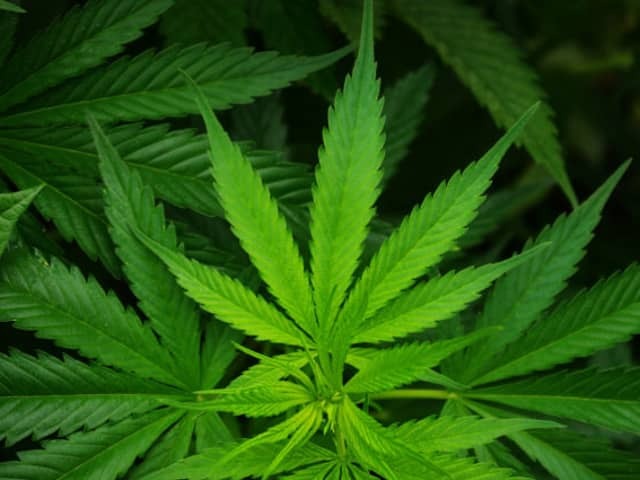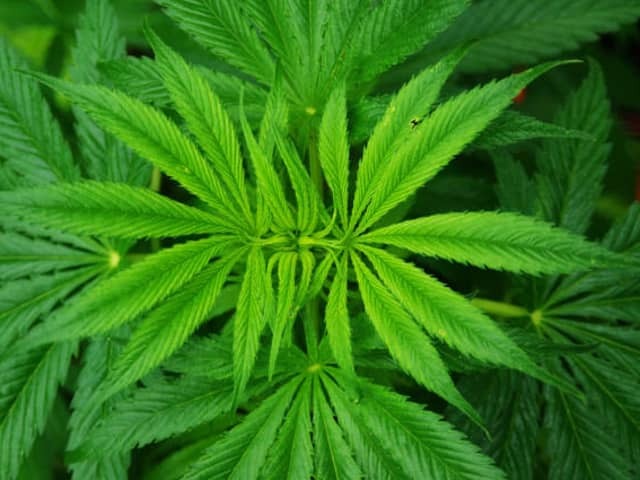Main menu
Common skin conditions

NEWS
Join DermNet PRO
Read more
Quick links
Cannabinoids in dermatology — extra information
Cannabinoids in dermatology
Author: Dr Varitsara Mangkorntongsakul, Senior Medical Officer, Central Coast Local Health District, NSW, Australia. Dr Yi Jia Lee, Junior Medical Officer, Sir Charles Gairdner Hospital, Nedlands, WA, Australia. Technical Editor: Mary-Elaine Luther, medical student, Ross University School of Medicine, Barbados. DermNet Editor in Chief: Adjunct A/Prof. Amanda Oakley, Dermatologist, Hamilton, New Zealand. Copy edited by Gus Mitchell. January 2020.
Introduction - cannabis
Introduction
Effects of cannabinoids on the body
Introduction - topical cannabinoids
Adverse effects
What is cannabis?
Cannabis refers to one of two notable subspecies of the cannabis plant.
- Cannabis sativa, also known as marijuana, has psychoactive properties.
- Cannabis sativa L., also known as hemp, is the non-psychoactive form of cannabis used in manufacturing products such as oil, cloth, and fuel. (The L was included in the name in honour of botanist Carl Linnaeus).
Cannabis is also known as pot, weed, hash, dope, ganja, joint, stick, yarndi, cone, mull, 420, dabs, dabbing, BHO, choof, and mull [1,2].
Cannabis comes in various forms [1].
- Marijuana — the dried leaves and flowers of the plant.
- Hashish — the resin of the dried plant, usually mixed with tobacco and smoked or added to foods and baked; levels of tetrahydrocannabinol (THC) are higher than in marijuana.
- Hash oil — a thick, golden-brown to black liquid extracted from hashish and added to the tip of a joint or cigarette and smoked; hash oil is used sparingly due to its high potency.
- Concentrates — extracts (dabs, wax, or shatter) typically use butane hash oil as a solvent and are vaporised in small quantities due to high content of THC.


What are cannabinoids?
Cannabinoid refers to any chemical substance that binds to the cannabinoid receptors CB1 and CB2 in the body producing similar effects to C. sativa. There are three types of cannabinoid [1,2].
- Plant-derived cannabinoids (phytocannabinoids), such as THC, which is found exclusively in cannabis plants.
- Endogenous cannabinoids (endocannabinoids), such as palmitoylethanolamide (PEA), anandamide (AEA), and oleoyl ethanolamide (OEA), which are produced naturally in the human body.
- Synthetic cannabinoids are produced in a laboratory. Synthetic cannabinoids are pure agonists with high affinity at the CB1 receptor, which contributes to their psychoactive effects. Synthetic cannabinoids can be taken orally or applied topically for a therapeutic effect.
What are the effects of cannabinoids on the body?
Cannabis can be smoked, ingested (eaten), or vaporised to induce a temporary state of euphoria and sense of relaxation [1]. The psychoactive properties of cannabis are primarily due to THC; THC concentration is commonly used as a measure of cannabis potency.
Endogenous and exogenous cannabinoids activate the cannabinoid receptors CB1 and CB2 [2–3].
- The CB1 receptor is expressed in the central and peripheral nervous systems, including vascular endothelium, liver, and adipose tissue.
- The CB2 receptor is mainly located in non-neuronal tissues and on immune cells throughout the whole body.
Activation of the CB1 receptor results in:
- Enhanced release of presynaptic dopamine in the dopaminergic mesolimbic system, which mediates the positive reinforcing and rewarding effects of almost all drugs of abuse [2]
- Reduced axon reflex–flare response, scratching reflex, and vasodilation in the skin [4]
- Inhibition of the anandamide-metabolising enzyme [fatty acid amide hydrolase (FAAH)]. The FAAH enzyme breaks down AEA into ethanolamine and arachidonic acid. Inhibiting AEA metabolism results in elevated endogenous AEA levels, which is therapeutic [4,5].
What are topical cannabinoids?
Topical cannabinoids are creams, patches, and gels containing plant-derived, endogenous, or synthetic cannabinoids that are intended for therapeutic use [6].
- Topical cannabinoids bind to cannabinoid receptors in sensory nerve fibres, inflammatory cells, and adnexal structures within the skin.
- This binding reduces pruritus, attenuates pain, mediates cellular response to ultraviolet B irradiation, inhibits epidermal keratinocyte proliferation, and promotes apoptotic death of keratinocytes [4,7,8].
- Binding of cannabinoid receptors also promotes anti-inflammatory effects relating to keratinocyte cytokine production and immune cell modulation [7].
In dermatology, topical cannabinoids are being investigated for the treatment of pruritus, inflammatory disorders, and skin cancer [4,9].
Topical cannabinoids in pruritus
Experimentally, creams containing PEA and synthetic cannabinoids have been shown to be effective and well-tolerated in the treatment of itch associated with atopic dermatitis, lichen simplex, nodular prurigo, and uraemia [2,5,10].
Topical cannabinoids in inflammatory skin disorders
Cannabinoids have immunosuppressive, anti-inflammatory, and other properties that may be useful in the treatment of inflammatory skin diseases, such as various forms of dermatitis, psoriasis, follicular disorders, and scleroderma [2,4,9,10].
Cannabinoids and skin cancer
The role of cannabinoids in skin cancer is confusing.
UVA and UVB can activate inflammation through the endocannabinoid system, thus potentially accelerating the initial stages of oncogenic transformation [5]. Cannabinoids can also promote oncogenic viral transformation as a result of their immunosuppressive properties [4,9].
However in animal models cannabinoids have been found to have anti-tumour effects mediated by both the CB1 receptor and especially the CB2 receptor. These anti-tumour effects are expressed on melanoma and keratinocyte cancers, resulting in the induction of apoptosis in tumours but not of normal melanocytes, and inhibition of [2,4,8]:
- Tumour cell growth, reducing melanoma progression and metastasis
- Tumour cell proliferation and migration
- Angiogenesis.
Other therapeutic uses for cannabinoids
Oral cannabinoids have been used in the treatment of cancer-related side effects such as chemotherapy-induced nausea and vomiting, pain, and poor appetite.
Cannabis extracts have shown the following benefits for multiple sclerosis:
- Reduce spasticity
- Reduce frequency of spasms
- Particularly effective for neuropathic pain
- Particularly effective for non-neuropathic pain in multiple sclerosis.
Cannabis extracts have also shown be beneficial in the treatment of chronic pain [3,7,11].
Other potential positive effects of cannabinoids include reducing the following:
- Tics due to Tourette syndrome
- Levodopa-induced dyskinesia in patients with Parkinson disease
- Anorexia and weight loss associated with human immunodeficiency virus (HIV) infection or acquired immune deficiency syndrome (AIDS).
Further studies are required to explore the potential benefits of medical cannabis for the treatment of the following conditions [3,7,11]:
- Irritable bowel syndrome
- Epilepsy
- Huntington disease
- Dementia
- Glaucoma
- Traumatic brain injury
- Addiction
- Anxiety
- Depression
- Sleep disorder
- Posttraumatic stress disorder
- Schizophrenia and other psychoses.
What are the adverse effects of cannabinoids?
Potential side effects and safety of topical cannabinoids have not been well elucidated. Some of the systemic effects of oral cannabinoids are listed below [3,11,12]:
Neurological |
Memory impairment, tremors, seizures |
Psychiatric/ mood |
Anxiety, confusion, agitation, mood dysregulation, paranoia, psychosis (short-term and long-term), suicidal ideation, perceptual disturbances |
Cardiac/ respiratory |
Diaphoresis, chest pain, acute myocardial infarction, hypertension, tachycardia |
Gastrointestinal |
Cannabinoid hyperemesis syndrome: abdominal pain, nausea, and vomiting; symptoms can be relieved with a warm shower |
Dermatological/ rheumatological |
Cannabinoid sensitisation or allergy; cannabis arteritis: severe vascular disease, leading to limb loss (see Thromboangiitis obliterans) |
References
- Alcohol and Drug Foundation. What is cannabis? [Internet]. Australia; 2019 June. Available from: adf.org.au/drug-facts/cannabis/ [accessed 1 Sept 2019]
- Eagleston LRM, Kalani NK, Patel RR, Flaten HK, Dunnick CA, Dellavalle RP. Cannabinoids in dermatology: a scoping review. Dermatol Online J. 2018 Jun 15;24(6):13030/qt7pn8c0sb. PMID: 30142706. PubMed
- Grotenhermen F, Müller-Vahl K. The therapeutic potential of cannabis and cannabinoids. Dtsch Arztebl Int. 2012 Jul;109(29-30):495-501. doi: 10.3238/arztebl.2012.0495. Epub 2012 Jul 23. PMID: 23008748; PMCID: PMC3442177. PubMed
- Mounessa JS, Siegel JA, Dunnick CA, Dellavalle RP. The role of cannabinoids in dermatology. J Am Acad Dermatol. 2017 Jul;77(1):188-90. doi: 10.1016/j.jaad.2017.02.056. Epub 2017 Apr 14. PMID: 28416341. PubMed
- Kupczyk P, Reich A, Szepietowski JC. Cannabinoid system in the skin - a possible target for future therapies in dermatology. Exp Dermatol. 2009 Aug;18(8):669-79. doi: 10.1111/j.1600-0625.2009.00923.x. PMID: 19664006. PubMed
- Hashim PW, Cohen JL, Pompei DT, Goldenberg G. Topical cannabinoids in dermatology. Cutis. 2017 Jul;100(1):50-2. PMID: 28873100. PubMed
- Ahsan A, B E, Bhowmick A, Bodner J, et al. The Risks and Benefits of Cannabis in the Dermatology Clinic [Internet]. Philadelphia, USA: Health Union, LLC; 2017 Nov. Available from: atopicdermatitis.net/living/risks-benefits-cannabis/ [cited 24 March 2018].
- Morris SY. Is Cannabis an Effective Treatment for Psoriasis?. San Francisco, CA; 2018 Jan. Available from: www.healthline.com/health/cannabis-psoriasis [accessed 24 March 2018]
- Maccarrone M, Di Rienzo M, Battista N, et al. The endocannabinoid system in human keratinocytes. Evidence that anandamide inhibits epidermal differentiation through CB1 receptor-dependent inhibition of protein kinase C, activation protein-1, and transglutaminase. J Biol Chem. 2003 Sep 5;278(36):33896-903. doi: 10.1074/jbc.M303994200. Epub 2003 Jun 18. PMID: 12815050. PubMed
- Caterina MJ. TRP channel cannabinoid receptors in skin sensation, homeostasis, and inflammation. ACS Chem Neurosci. 2014 Nov 19;5(11):1107-16. doi: 10.1021/cn5000919. Epub 2014 Jun 17. PMID: 24915599; PMCID: PMC4240254. PubMed
- Casanova ML, Blázquez C, Martínez-Palacio J, et al. Inhibition of skin tumor growth and angiogenesis in vivo by activation of cannabinoid receptors. J Clin Invest. 2003 Jan;111(1):43-50. doi: 10.1172/JCI16116. PMID: 12511587; PMCID: PMC151833. PubMed
- National Academies of Sciences E, Medicine. Therapeutic Effects of Cannabis and Cannabinoids. The health effects of cannabis and cannabinoids: The current state of evidence and recommendations for research: National Academies Press (US); 2017.
On DermNet
Other websites
- Marijuana’s History: How One Plant Spread Through the World — Live Science 2014
- Prescribing cannabis-based products — New Zealand Ministry of Health 2019
- Medicinal cannabis products: patient information — Australian Therapeutic Goods Administration (TGA) 2019
- FDA Regulation of Cannabis and Cannabis-Derived Products, Including Cannabidiol — U.S. Food & Drug Administration 2020
- Medical cannabis (and cannabis oils) — United Kingdom NHS 2018
